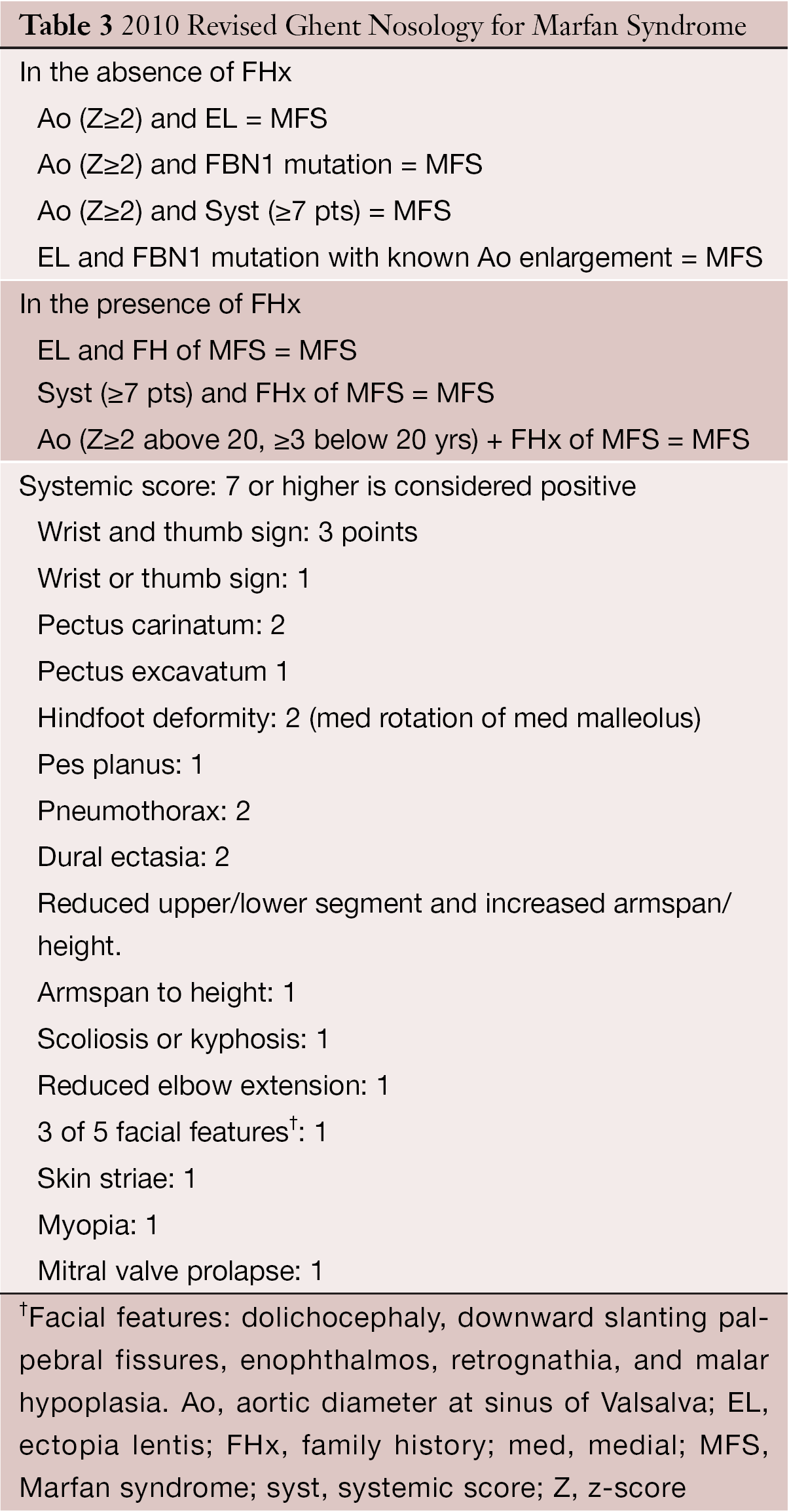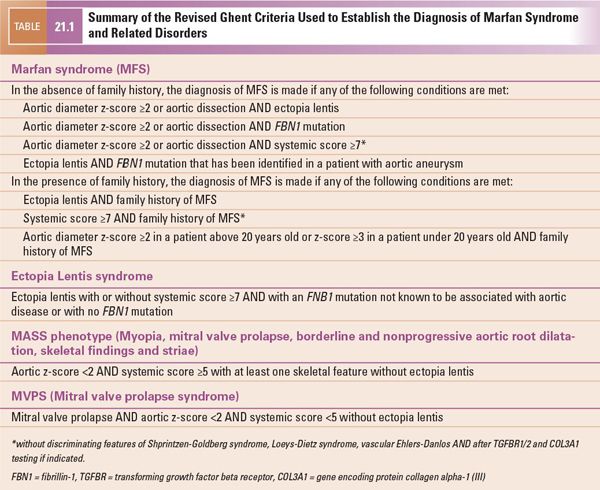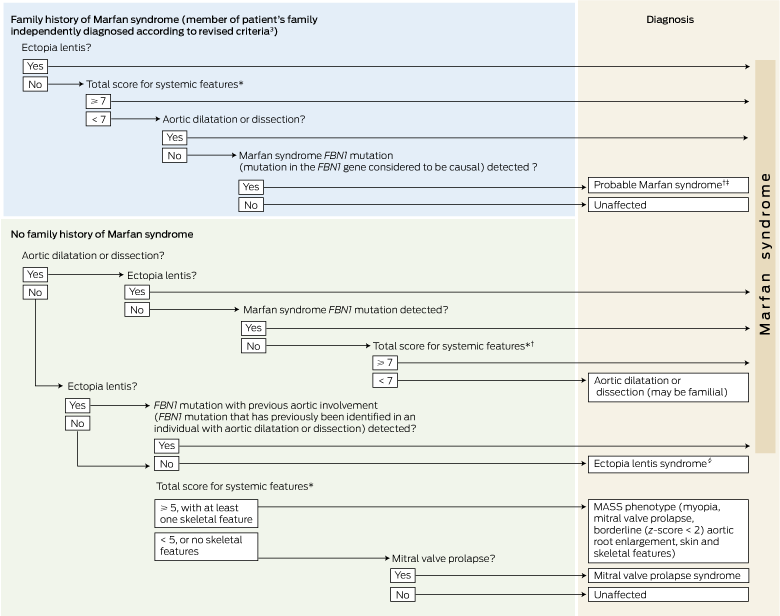Ghent Criteria For Marfan Syndrome
Ghent criteria for marfan syndrome. The diagnosis can be difficult due to the multiple clinical manifestations. These Ghent criteria comprising a set of major and minor. 624417-26 Skeletal Major presence of at least 4 of the following manifestations pectus carinatum pectus excavatum requiring surgery reduced upper to lower.
New molecular techniques allow the detection of FBN1 mutations in up to 97 of Marfan patients who fulfil the Ghent criteria. Those with the condition tend to be tall and thin with long arms legs fingers and toes. To decrease the risk of premature or missed diagnosis an international panel of experts revised the criteria in 2010.
The diagnosis of Marfan syndrome MFS is challenging and international criteria have been proposed. Revised Ghent criteria for the diagnosis of Marfan syndrome MFS and related conditions 14 In the absence of a family history. II - Ghent criteria for the diagnosis of Marfan syndrome De Paepe A et al Am J Med Genet.
The presence of 3 of 4 major criteria. Descrito por primera vez en 1896 por el pediatra francés Antoine-Bernard Marfan 2 e incluido en 1955 en una clasificación de enfermedades del tejido conectivo 3 no fue hasta 1986 cuando un panel internacional de expertos 4 definió un conjunto de criterios clínicos nosología de Berlín para el diagnóstico del SMF con una modificación posterior en 1996 5 referida desde entonces como. Old and a family history of Marfan syndrome as defined in 1-4 above is sufficient for a diagnosis of Marfan syndrome.
In 1996 the Ghent criteria updated the previous guidelines to include. The Ghent criteria consists of major and minor criteria. The diagnosis of Marfan syndrome MFS is challenging and international criteria have been proposed.
The revised Ghent nosology for the Marfan syndrome The diagnosis of Marfan syndrome MFS relies on defined clinical criteria Ghent nosology outlined by international expert opinion to facilitate accurate recognition of this genetic aneurysm syndrome and to improve patient management and counselling. Based on the revised Ghent criteria in the absence of family history with aortic dilatation Z2 ectopia lentis and systemic score of 9 wrist and thumb sign-3 pectus carinatum-2 scoliosis-1 facial features-1 myopia3 diopter-1 mitral valve prolapse-1 the case was confirmed as Marfan syndrome. The diagnosis of Marfan syndrome MFS relies on defined clinical criteria Ghent nosology outlined by international expert opinion to facilitate accurate recognition of this genetic aneurysm syndrome and to improve patient management and counselling.
The diagnosis of Marfan syndrome MFS relies on defined clinical criteria Ghent nosology outlined by international expert opinion to facilitate accurate recognition of this genetic aneurysm. The diagnosis of Marfan syndrome relies on a set of defined clinical criteria the Ghent nosology developed to facilitate accurate recognition of the syndrome and improve patient management and counseling.
The major criteria are features or symptoms common in people with Marfan syndrome that are rare in people who do not have it.
We aimed to compare the diagnosis reached by applying this new nosology vs the Ghent nosology in a well-known series of 1009. The 1996 Ghent criteria were adopted worldwide but new diagnostic criteria for MFS were released in 2010 giving more weight to aortic root aneurysm and ectopia lentis. Aortic dilation or dissection. The diagnosis of Marfan syndrome MFS is challenging and international criteria have been proposed. These Ghent criteria comprising a set of major and minor. The major criteria are features or symptoms common in people with Marfan syndrome that are rare in people who do not have it. Old 3 below 20 yrs. Old and a family history of Marfan syndrome as defined in 1-4 above is sufficient for a diagnosis of Marfan syndrome. Prevention of aortic dissection and sudden death in Marfan syndrome MFS requires accurate diagnosis.
What are the revised Ghent criteria for the diagnosis of Marfan syndrome MFS. We applied the revised Marfan nosology. To decrease the risk of premature or missed diagnosis an international panel of experts revised the criteria in 2010. The major criteria are features or symptoms common in people with Marfan syndrome that are rare in people who do not have it. New molecular techniques allow the detection of FBN1 mutations in up to 97 of Marfan patients who fulfil the Ghent criteria. Lens subluxation ectopia lentis Musculoskeletal findings. In 1996 the Ghent criteria updated the previous guidelines to include.










































Post a Comment for "Ghent Criteria For Marfan Syndrome"